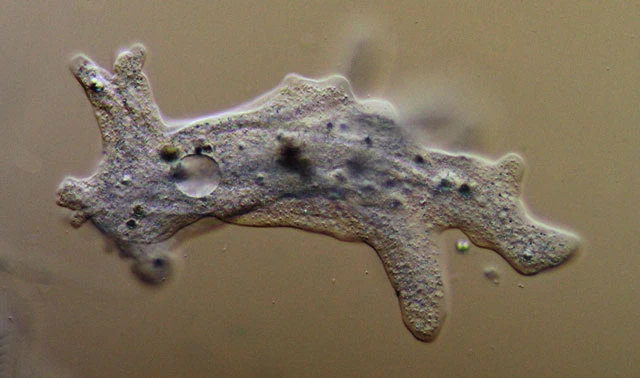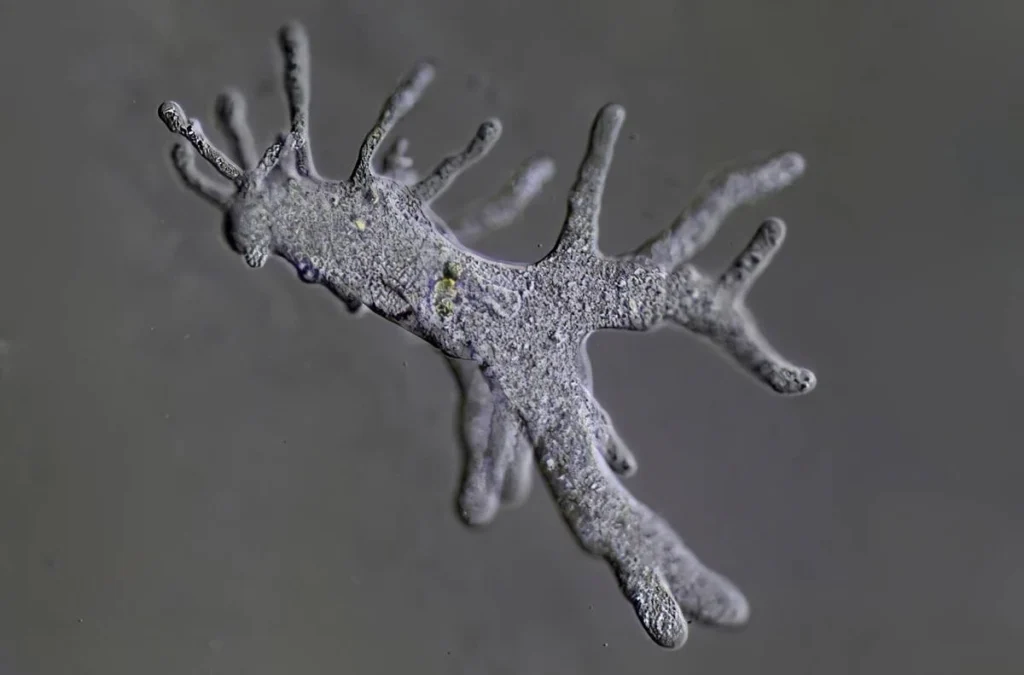Common amoeba (Amoeba proteus)-one of the most famous representatives of the simplest single-celled organisms. It is a classic object of research in microbiology, biology, and zoology. Despite its simple structure, this microorganism has unique abilities to move, feed, and reproduce, which makes it an important component of freshwater ecosystems.
In this article, we will look in detail at the structure, lifestyle, reproduction, the importance of the common amoeba in nature, as well as its interaction with other organisms.

1. General characteristics of the common amoeba
🔬 Scientific classification:
✔ The Kingdom: The simplest ones (Protozoa)
✔ Type: Amoebozoa (Amoebozoa)
✔ Class: Tubulineae (Tubulinea)
✔ Row: Amoebae (Amoebida)
✔ Family: Amoebae (Amoebidae)
✔ Gender: Amoeba (Amoeba)
✔ View: Amoeba proteus
📌 Other names:
✔ Proteus-amoeba (thanks to its shape-shifting ability)
✔ Free-living amoeba
📍 Living environment:
It lives in fresh water bodies with clear water - in ponds, lakes, streams, as well as in moist soil.
📏 Sizes:
From 250 microns to 700 microns (0.25-0.7 mm), which allows you to observe it under a microscope.
2. Structure and physiology of the amoeba
Unlike multicellular organisms, an amoeba consists of only one cell that performs all vital functions.
🔎 Main parts of the amoeba cell:
✔ Plasma membrane - the outer shell of the cell, protecting it and maintaining its shape
✔ Cytoplasm - the internal contents of the cell, divided into two parts:
• Ectoplasm (outer layer, more dense)
• Endoplasm (the inner layer, which is more liquid, contains organelles)
✔ The core - controls the vital activity of the cell and contains DNA
✔ Vacuoles:
• Contractile vacuole - regulates the water balance by removing excess fluid
• Digestive vacuole - contains enzymes to break down food
✔ Pseudopodia (fake legs) - used for moving and grabbing food
📌 Interesting!
Pseudopods do not have a permanent shape-the amoeba can pull them in any direction, which provides it with a unique way of moving and hunting.
3. method of transportation
The amoeba moves with the help of pseudopods that change their shape. The process occurs due to the movement of the cytoplasm:
✔ A pseudopodia is formed in the desired direction
✔ Cytoplasm flows into the new structure
✔ The rest of the cage "pulls up" behind it
This method of driving is called amoeboid movement.
📌 Interesting!
The amoeba moves slowly-its speed is about 0.5 mm per minute.
4. Nutrition and digestion
The amoeba is a heterotrophic organism, meaning it is not capable of photosynthesis and receives nutrients from the environment.
🍽 Nutrition process (phagocytosis):
1. The amoeba approaches a food particle (such as bacteria, single-celled algae, or organic debris).
2. Pseudopodia surround food and form a digestive vacuole around it
3. enzymes inside the vacuole break down organic substances
4. useful substances are absorbed into the cytoplasm, and undigested residues are thrown out
📌 Interesting!
The amoeba can even feed on other protozoa.

5. breathing and discharge
🔹 Dihanie:
The amoeba receives oxygen by diffusion-gas exchange occurs through the cell membrane.
🔹 Highlighting:
✔ Unnecessary substances and excess water are removed through contractile vacuole
✔ Toxic substances are released by diffusion through the membrane
6. reproduction of the amoeba
The amoeba reproduces asexually - by dividing the cell in half.
🔄 The breeding process:
1. The core is divided into two parts
2. the cage gradually stretches
3. a constriction is formed that divides the mother cell into two daughter cells
📌 Interesting!
Under favorable conditions, one amoeba can produce several generations in a day!
7. the role of the amoeba in nature
🌿 Importance in natural ecosystems:
✔ Participant in the cycle of substances-decomposes organic matter and dead remains
✔ Controls the number of bacteria and other micro-organisms
✔ Serves as food for larger microorganisms
🦠 Relationships with other organisms:
✔ Amoebas can form symbiotic interactions with bacteria
Some types of amoebas are parasites (for example, Entamoeba histolytica causes amoebiasis in humans)
8. Interesting facts about the amoeba
✔ The amoeba can form a cyst - a protective shell that helps you survive adverse conditions
✔ It has no brain, but is able to "remember" favorable and unfavorable conditions
The amoeba was first described in the 18th century by Anton van Leeuwenhoek
Conclusion
Amoeba vulgaris is an amazing microscopic organism that, despite its simple structure, has a complex lifestyle. It plays an important role in nature, participates in the cycle of substances and is an indispensable object for biological research. Thanks to its unique abilities, the amoeba remains one of the most interesting protozoa on Earth.
